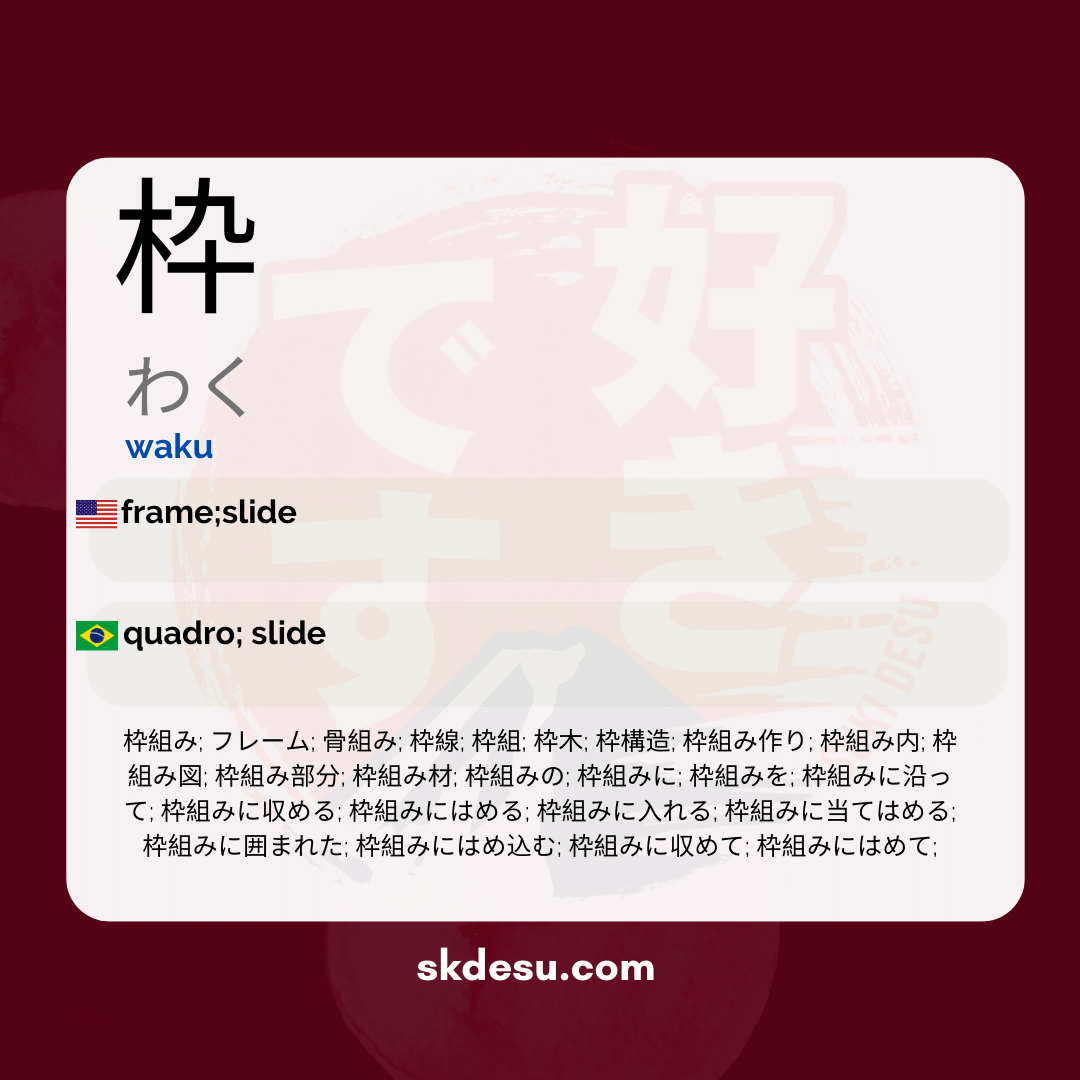Translation and Meaning of: 枠 - waku
On this page, we will study the meaning of the Japanese word 枠 (waku) and its translation into English. Let's see their different meanings, example phrases, explanations, etymology and the similar words.
Romaji: waku
Kana: わく
Type: noun
L: jlpt-n1
Translation / Meaning: frame; slide
Meaning in English: frame;slide
Definition: A square-shaped container for storing things.
Sumário
- Etymology
- Vocabulary
- Writing
- Phrases
Explanation and Etymology - (枠) waku
The Japanese word 「枠」 (waku) is quite versatile and used in various contexts. Originally, 「枠」 is a noun that means "frame" or "border," encompassing the sense of a structure that delineates something. In practice, this word can refer to limits or outlines, whether of a physical frame, such as that of a picture, or figurative restrictions, such as those of a project or a concept. This idea of delimitation adds value to the term when applied in analyses or discussions about limits, structures, and planning.
Etimologically, 「枠」 is composed of the kanji 「木」 (ki), which means "wood", and the radical 「由」, which, in this composition, enhances the sense of linear structure, like slats or support bars. The origin of this term is related to the traditional use of wooden frames in Japanese art and construction, which explains the association with "frame". These components help understand its use, as they direct the interpretation toward constructive and delimiting elements, typical in many ancient wooden Japanese constructions.
In everyday life, 「枠」 appears in a variety of contexts. For example, in business areas, it is common to see the term used to indicate a "frame" or "budget limit." On television, it can refer to the programming highlighting a "specific time" or "time slot" that protects a certain program. The versatility of 「枠」 in allowing such varied interpretations makes it a valuable term in the Japanese language, especially in discussions about structure and organization.
Furthermore, the application of the term is not limited to material situations. 「枠」 can also be used figuratively to describe social barriers or cultural restrictions. For example, when speaking of "behavioral standards" within a society, the term can describe the invisible outline within which people are expected to act. Thus, the metaphorical use of 「枠」 symbolizes how certain concepts and norms are shaped and internalized in different societies and cultures.
Synonyms and similar words
- 枠組み (wakugumi) - Structure or framework of an object or project
- フレーム (fureemu) - Frame; often used in design or photography contexts
- 骨組み (honegumi) - Skeletal structure; refers to the structural part that supports a building
- 枠線 (wakusen) - Contour lines or frames; used in diagrams or illustrations
- 枠木 (wakugi) - Molding woods; refers to pieces of wood that form a frame.
- 枠構造 (waku kouzou) - Frame structure; the system or configuration of a frame
- 枠組み作り (wakugumi zukuri) - Construction of a structure; act of creating a frame or structure
- 枠組み内 (wakugumi nai) - Within the structure; refers to what is contained in a frame
- 枠組み図 (wakugumi zu) - Structure diagram; illustration that represents the structure
- 枠組み部分 (wakugumi bubun) - Part of the structure; refers to specific sections within a framework.
- 枠組み材 (wakugumi zai) - Frame materials; the materials used in the construction of the frame.
- 枠組みの (wakugumi no) - Of the frame; used to indicate possession in relation to a structure
- 枠組みに (wakugumi ni) - Within the structure; indicates the context or action related to the structure.
- 枠組みを (wakugumi o) - Regarding the structure; generally used to indicate the action towards a structure
- 枠組みに沿って (wakugumi ni sotte) - Throughout the structure; refers to something that follows the shape of the frame
- 枠組みに収める (wakugumi ni osameru) - Place within the structure; refers to putting something inside a frame.
- 枠組にはめる (wakugumi ni hameru) - Fit into the structure; means to adjust or place something in the frame.
- 枠組みに入れる (wakugumi ni ireru) - Insert into the structure; refers to placing something within the frame.
- 枠組みに当てはめる (wakugumi ni atehameru) - Adjust to the structure; it means adapting something to fit into the frame.
- 枠組みに囲まれた (wakugumi ni kakomareta) - Surrounded by the structure; it means being encircled by a frame.
- 枠組にはめ込む (wakugumi ni hakekomu) - Fit into the structure; the act of fixing something so that it adjusts perfectly to the frame.
- 枠組みに収めて (wakugumi ni osamete) - Placed in the structure; act of putting something in its frame.
- 枠組みにはめて (wakugumi ni hamete) - Fitted in the structure; refers to the act of properly adjusting something in the frame
Words related
Words with the same pronunciation: わく waku
How to Write in Japanese - (枠) waku
See below a step-by-step guide on how to write the word by hand in Japanese (枠) waku:
Example Sentences - (枠) waku
Below are some example sentences:
Kono e wa waku ni awasete kazatte kudasai
Please put this image framed on the wall.
Please decorate this photo according to the board.
- この - this
- 絵 - Image
- は - topic particle
- 枠 - frame
- に - target particle
- 合わせて - adjust, combine
- 飾って - hang, decorate
- ください - please, please about
madowaku ni te wo tsuppuru
I rest my hand on the window frame.
Push your hand into the window frame.
- 窓枠 (madowaku) - window frame
- に (ni) - particle indicating location
- 手 (te) - mão
- を (wo) - particle that indicates the object of the action
- 突っ張る (tsuppashiru) - lean on tightly
Other words of the same type: noun
See other words from our dictionary that are also: noun

